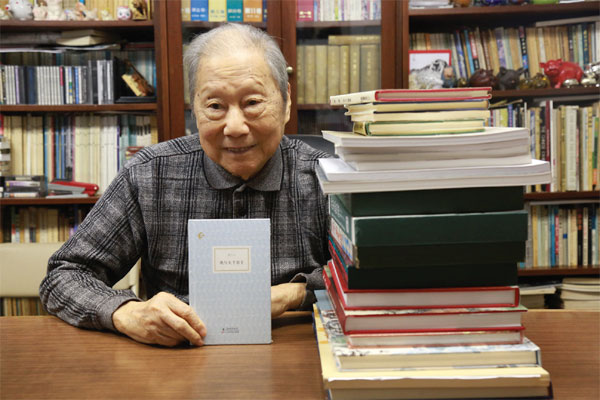Johnson Su-sing Chow: Literati Painter, traveler
For Johnson Su-sing Chow, the renowned Chinese literati painter, there is an end to life, but there are no boundaries in art.
The 92-year-old artist who lives in Vancouver is widely known for his passion in the classics, poetry, calligraphy, landscape and bird-and-flower ink painting.
"For me, painting is equally important as life. As long as I'm living, I will not stop working for art," said Chow in an interview with China Daily. "Since I moved to Canada 35 years ago, I have not given up contributing to the world of Chinese art. I refuse to do anything else such as making a fortune. My aspiration for life is to promote the traditional Chinese art and culture to the world."
Born in Suzhou, China, Chow began painting at the age of 8 and eventually excelled in the fundaments of Chinese art because of his family. Thanks to support from his family. His father, Zhou Chilu, encouraged him to paint; his brother Zhou Yujing instructed him in the skills of bamboo and seal carving, and his uncle Zhou Mutian taught him poetry, verse, and the art of calligraphy.
The young artist was accepted to study with Wu School masters at Suzhou Fine Arts College where he learned the painting of flowers with Wu Silan, the details of depicting fruit and vegetables with Liu Junran, and birds and insects with Zhang Xingjie. During those years of studies, Chow loved to spend his spare time at his teacher Wu Silan's studio, which housed a rich collection of paintings and books.
In 1944, Chow graduated from the arts college, highly skilled at traditional Chinese ink and brush painting, as well as knowledge of contemporary and fine art from East and West.
To evade the Chinese civil war, Chow went to Hong Kong in June1949. He continued painting while he worked at a local bookstore to earn a living. Eventually he taught Chinese painting, and became acquainted with the Chinese art masters Wu Zishen and Zhang Daqian. Chow and Zhang became close friends, and Chow even published a book Danqian and I. The literati painter was also inspired by Zhang to do an in-depth study of the art of Bada Shanren, and freely paint landscapes in splashed ink.
Tang Shixia, the niece of the Imperial Consort Zhen, concubine of Emperor Guangxu of the Qing dynasty, and Yang Shiqiang, the granddaughter of Yang Hanxi from a distinguished family in Wuxi, Jiangsu province were some of Chow's famous students in Hong Kong. As the number of his students increased, Chow became more influential in the world of art.
When the Hong Kong Chinese Art Club was formed, Chow was elected vice -chairman. He and many scholars frequently held gatherings and put on cultural events where Chow formed a friendship with painters of the Ningnan School, including BaoShaoyou, Zhao Shao'ang, Deng Fen and Yang Shanshen.
During his 21 years in Hong Kong, Chow held many solo exhibitions, and had his works shipped to New York for exhibition on the recommendation of the Hong Kong branch of the World Christian Council. Chow published his first album with eighty paintings in 1968. He was also invited to lecture on bird-and-flower painting and other topics at the New Asia College and the Chinese University of Hong Kong.
In 1971, Chow t left Hong Kong, which he called his second homeland, to begin his journey to the United States and Canada with his family.
After moving to California, Chow taught advanced studies at the University of California, Los Angeles, and served as curator of Chinese art at the Asian Pacific Art Museum until 1980. Then he moved to Vancouver where he became a professor and mentor at the University of British Columbia, teaching classical painting.
"At that time the university did not have a formal course on the subject, and so it was only offered as an extension course. As it was the first of its kind, the course attracted a lot of students, and many of them were Caucasians," said Chow. "As to most of them, it was the first time they ever got in touch with Chinese paintings; their learning spirit was high. They were amazed at how a brush could paint such beautiful objects with such ease and clarity."
After six years Chow left the university to pursue other goals, but some of the students who enjoyed his teaching became his private students.
Besides teaching, Chow spent time with famous Chinese artists in Canada, including F.C. Chan,Yukman Lai, S.F. Leung and K. Seto. They would hold monthly meetings, sharing their artistic talents by painting and discussing their artwork and calligraphies at the Buddhist Temple in Richmond.
In 1993, Chow founded the Chinese Canadian Artists Federation in Vancouver, which now has more than 400 members. Many of the members were accomplished artist before settling in Vancouver.
"We often have joint-exhibitions to display our art for cultural exchanges, not only between members, but to the public as well. I also have quite a few students who over the years have become known artists in town," Chow said.
Chow has donated many of his artworks to charitable organizations, and supported many local cultural events. Both the Canadian provincial and municipal governments have awarded him civil honors for his contribution to the artistic and cultural mosaic of British Columbia
In 2012, Chow founded the Wu School Art Association with Linda Hu to further the traditional Chinese painting style that was handed down from the Tang Dynasty to the present, and the mix of old and new styles he mastered in the Wu School. He hopes through this association that ,the members of the association and his students can promote Chinese traditional painting.
|
Johnson Su-sing Chow with his publications in his Vancouver home. Vincent Li / for China Daily |



















